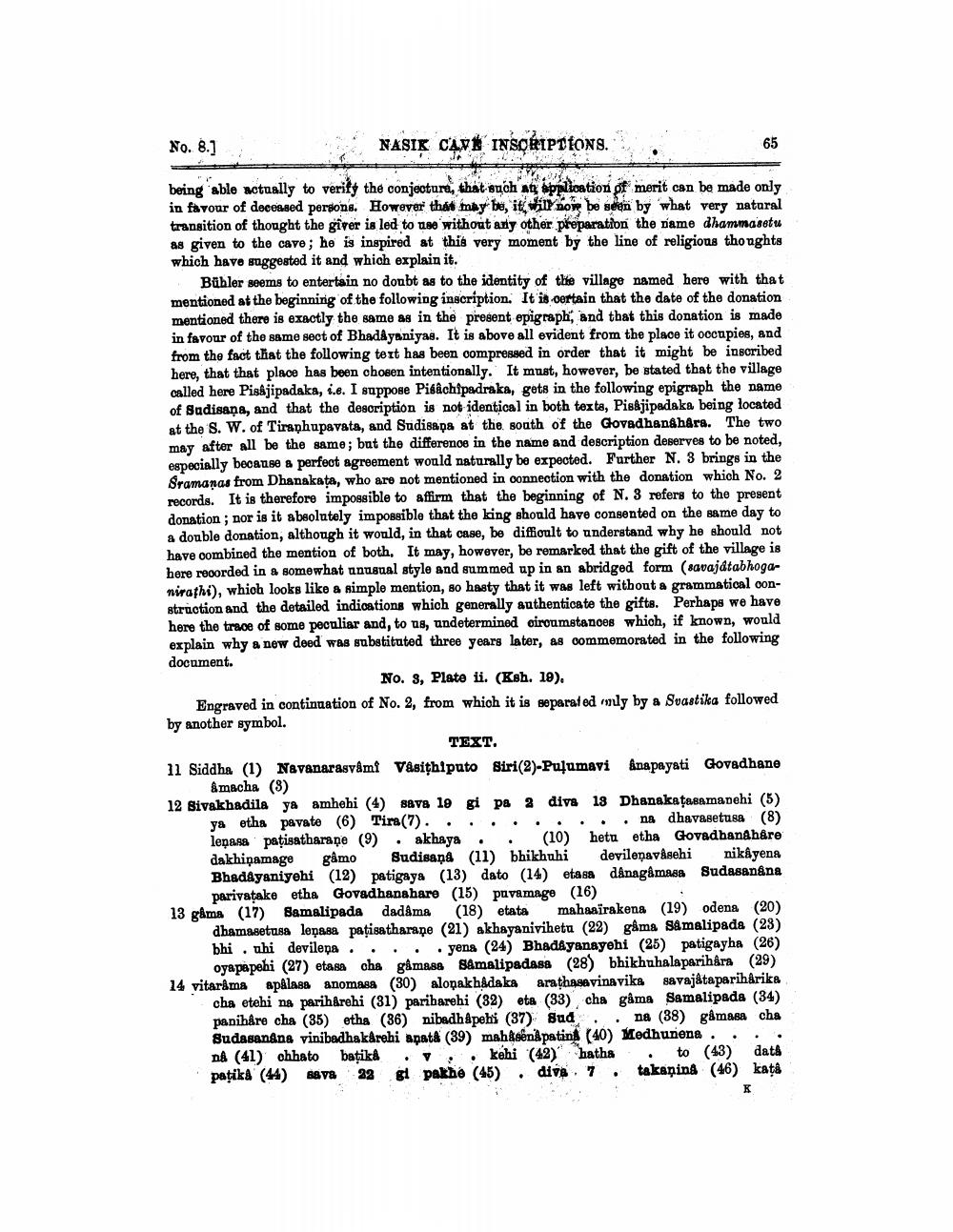________________
No. 8.1
NASIK CAVE INSCRIPTIONS.
being able actually to verify the conjectura, that such an application of merit can be made only in favour of deceased persons. However that may be, it will now be seen by what very natural transition of thought the giver is led to use without any other preparation the name dhammasetu as given to the cave; he is inspired at this very moment by the line of religious thoughts which have suggested it and which explain it.
Bühler seems to entertain no doubt as to the identity of the village named here with that mentioned at the beginning of the following inscription. It is certain that the date of the donation mentioned there is exactly the same as in the present epigraph, and that this donation is made in favour of the same sect of Bhadâyaniyas. It is above all evident from the place it occupies, and from the fact that the following text has been compressed in order that it might be inscribed here, that that place has been chosen intentionally. It must, however, be stated that the village called here Pisâjipadaka, i.e. I suppose Pisâchipadraka, gets in the following epigraph the name of Sudisana, and that the description is not identical in both texts, Pisâjipadaka being located at the S. W. of Tiraphupavata, and Sudisapa at the south of the Govadhanahara. The two may after all be the same; but the difference in the name and description deserves to be noted, especially because a perfect agreement would naturally be expected. Further N. 3 brings in the Sramanas from Dhanakata, who are not mentioned in connection with the donation which No. 2 records. It is therefore impossible to affirm that the beginning of N. 3 refers to the present donation; nor is it absolutely impossible that the king should have consented on the same day to a double donation, although it would, in that case, be difficult to understand why he should not have combined the mention of both. It may, however, be remarked that the gift of the village is here recorded in a somewhat unusual style and summed up in an abridged form (savajátabhoganirathi), which looks like a simple mention, so hasty that it was left without a grammatical construction and the detailed indications which generally authenticate the gifts. Perhaps we have here the trace of some peculiar and, to us, undetermined circumstances which, if known, would explain why a new deed was substituted three years later, as commemorated in the following document.
No. 3, Plate ii. (Ksh. 10).
Engraved in continuation of No. 2, from which it is separated mly by a Svastika followed by another symbol.
TEXT.
•
65
11 Siddha (1) Navanarasvami Vasithiputo Siri(2)-Pulumavi Anapayati Govadhane Amacha (3)
12 Sivakhadila ya amhehi (4) sava 19 gi pa 2 diva 13 Dhanakaṭasamanehi (5) ya etha pavate (6) Tira(7). na dhavasetusa (8) lepasa patisatharape (9) akhaya (10) hetu etha Govadhanahâre dakhiņamage gâmo Sudisana (11) bhikhuhi devileṇavâsehi nikâyena Bhadâyaniyehi (12) patigaya (13) dato (14) etasa dânagâmasa Sudasanana parivaṭake etha Govadhanahare (15) puvamage (16)
13 gåma (17) Samalipada dadâma (18) etata mahaaïrakena (19) odena (20) dhamasetusa lepasa patisatharape (21) akhayanivihetu (22) gåma Samalipada (23) bhi uhi devilepa yena (24) Bhadâyanayehi (25) patigayha (26) oyapapehi (27) etasa cha gâmasa Samalipadasa (28) bhikhuhalaparihara (29) 14 vitarama apalasa anomasa (30) alopakhadaka arathasavinavika savajâtaparihârika cha etehi na parihârehi (31) pariharehi (32) eta (33) cha gâma Samalipada (34) panihâre cha (35) etha (36) nibadhâpehi (37) Bud na (38) gâmasa cha Sudasanana vinibadhakarehi apata (39) mahksena patina (40) Medhunena. nå (41) chhato batika kehi (42) hatha patika (44) sava 22 gi pakhe (45) diva 7
•
•
data to (43) takanina (46) kata
K




